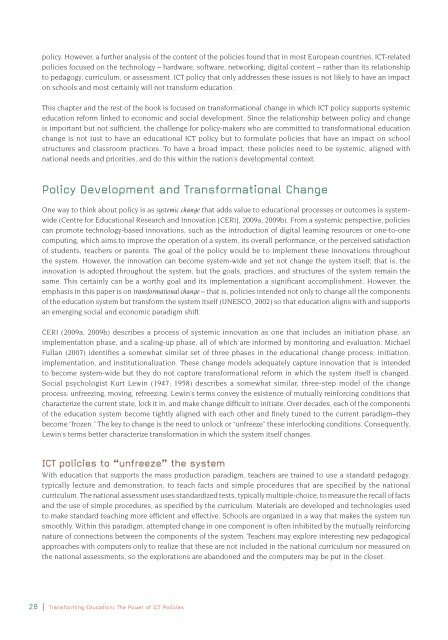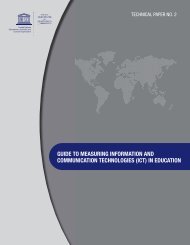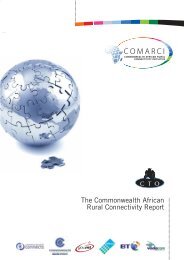Transforming education: the power of ICT policies - Commonwealth ...
Transforming education: the power of ICT policies - Commonwealth ...
Transforming education: the power of ICT policies - Commonwealth ...
You also want an ePaper? Increase the reach of your titles
YUMPU automatically turns print PDFs into web optimized ePapers that Google loves.
policy. However, a fur<strong>the</strong>r analysis <strong>of</strong> <strong>the</strong> content <strong>of</strong> <strong>the</strong> <strong>policies</strong> found that in most European countries, <strong>ICT</strong>-related<br />
<strong>policies</strong> focused on <strong>the</strong> technology – hardware, s<strong>of</strong>tware, networking, digital content – ra<strong>the</strong>r than its relationship<br />
to pedagogy, curriculum, or assessment. <strong>ICT</strong> policy that only addresses <strong>the</strong>se issues is not likely to have an impact<br />
on schools and most certainly will not transform <strong>education</strong>.<br />
This chapter and <strong>the</strong> rest <strong>of</strong> <strong>the</strong> book is focused on transformational change in which <strong>ICT</strong> policy supports systemic<br />
<strong>education</strong> reform linked to economic and social development. Since <strong>the</strong> relationship between policy and change<br />
is important but not suffi cient, <strong>the</strong> challenge for policy-makers who are committed to transformational <strong>education</strong><br />
change is not just to have an <strong>education</strong>al <strong>ICT</strong> policy but to formulate <strong>policies</strong> that have an impact on school<br />
structures and classroom practices. To have a broad impact, <strong>the</strong>se <strong>policies</strong> need to be systemic, aligned with<br />
national needs and priorities, and do this within <strong>the</strong> nation’s developmental context.<br />
Policy Development and Transformational Change<br />
One way to think about policy is as systemic change that adds value to <strong>education</strong>al processes or outcomes is systemwide<br />
(Centre for Educational Research and Innovation [CERI], 2009a, 2009b). From a systemic perspective, <strong>policies</strong><br />
can promote technology-based innovations, such as <strong>the</strong> introduction <strong>of</strong> digital learning resources or one-to-one<br />
computing, which aims to improve <strong>the</strong> operation <strong>of</strong> a system, its overall performance, or <strong>the</strong> perceived satisfaction<br />
<strong>of</strong> students, teachers or parents. The goal <strong>of</strong> <strong>the</strong> policy would be to implement <strong>the</strong>se innovations throughout<br />
<strong>the</strong> system. However, <strong>the</strong> innovation can become system-wide and yet not change <strong>the</strong> system itself; that is, <strong>the</strong><br />
innovation is adopted throughout <strong>the</strong> system, but <strong>the</strong> goals, practices, and structures <strong>of</strong> <strong>the</strong> system remain <strong>the</strong><br />
same. This certainly can be a worthy goal and its implementation a signifi cant accomplishment. However, <strong>the</strong><br />
emphasis in this paper is on transformational change – that is, <strong>policies</strong> intended not only to change all <strong>the</strong> components<br />
<strong>of</strong> <strong>the</strong> <strong>education</strong> system but transform <strong>the</strong> system itself (UNESCO, 2002) so that <strong>education</strong> aligns with and supports<br />
an emerging social and economic paradigm shift.<br />
CERI (2009a, 2009b) describes a process <strong>of</strong> systemic innovation as one that includes an initiation phase, an<br />
implementation phase, and a scaling-up phase, all <strong>of</strong> which are informed by monitoring and evaluation. Michael<br />
Fullan (2007) identifi es a somewhat similar set <strong>of</strong> three phases in <strong>the</strong> <strong>education</strong>al change process: initiation,<br />
implementation, and institutionalization. These change models adequately capture innovation that is intended<br />
to become system-wide but <strong>the</strong>y do not capture transformational reform in which <strong>the</strong> system itself is changed.<br />
Social psychologist Kurt Lewin (1947; 1958) describes a somewhat similar, three-step model <strong>of</strong> <strong>the</strong> change<br />
process: unfreezing, moving, refreezing. Lewin’s terms convey <strong>the</strong> existence <strong>of</strong> mutually reinforcing conditions that<br />
characterize <strong>the</strong> current state, lock it in, and make change diffi cult to initiate. Over decades, each <strong>of</strong> <strong>the</strong> components<br />
<strong>of</strong> <strong>the</strong> <strong>education</strong> system become tightly aligned with each o<strong>the</strong>r and fi nely tuned to <strong>the</strong> current paradigm–<strong>the</strong>y<br />
become “frozen.” The key to change is <strong>the</strong> need to unlock or “unfreeze” <strong>the</strong>se interlocking conditions. Consequently,<br />
Lewin’s terms better characterize transformation in which <strong>the</strong> system itself changes.<br />
<strong>ICT</strong> <strong>policies</strong> to “unfreeze” <strong>the</strong> system<br />
With <strong>education</strong> that supports <strong>the</strong> mass production paradigm, teachers are trained to use a standard pedagogy,<br />
typically lecture and demonstration, to teach facts and simple procedures that are specifi ed by <strong>the</strong> national<br />
curriculum. The national assessment uses standardized tests, typically multiple-choice, to measure <strong>the</strong> recall <strong>of</strong> facts<br />
and <strong>the</strong> use <strong>of</strong> simple procedures, as specifi ed by <strong>the</strong> curriculum. Materials are developed and technologies used<br />
to make standard teaching more effi cient and effective. Schools are organized in a way that makes <strong>the</strong> system run<br />
smoothly. Within this paradigm, attempted change in one component is <strong>of</strong>ten inhibited by <strong>the</strong> mutually reinforcing<br />
nature <strong>of</strong> connections between <strong>the</strong> components <strong>of</strong> <strong>the</strong> system. Teachers may explore interesting new pedagogical<br />
approaches with computers only to realize that <strong>the</strong>se are not included in <strong>the</strong> national curriculum nor measured on<br />
<strong>the</strong> national assessments, so <strong>the</strong> explorations are abandoned and <strong>the</strong> computers may be put in <strong>the</strong> closet.<br />
28 | <strong>Transforming</strong> Education: The Power <strong>of</strong> <strong>ICT</strong> Policies
















